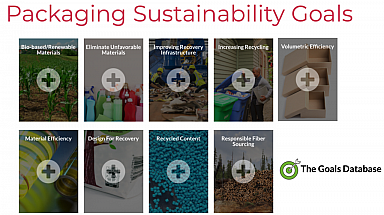November 12, 2019
This guest blog was written by Tristanne Davis, Senior Manager, Sustainable Packaging Coalition (SPC), and appeared on the SPC website.
An ever growing list of brands, retailers and even packaging suppliers are making headlines by setting sustainable packaging goals to achieve by 2025, 2030 and beyond. Collective goals like the New Plastics Economy Global Commitment and UK Plastics Pact are also gaining more signatories and momentum. In the SPC’s newly released Essentials of Goal Setting course, we unpack considerations for setting sustainable packaging goals.
As the pressure on industry grows to take action on sustainability, goals increasingly impact companies’ bottom line, their social license to operate, and their status in the eyes of NGOs, consumers, and regulators. Setting good goals is the beginning of a sustainability journey. Through goal setting, you create your vision and align your organization around this vision, creating a blueprint for action.
While there is a flurry of goals being set, there’s still a need to connect these goals to a larger vision and set up your company for action and impact. This course attempts to explore these gaps, and helps guide companies to ask the right questions and navigate their own path.
Let’s explore some of the course’s key guidance for setting effective goals.
Define priority areas for your company’s strategy.
In setting goals it is important to focus on issues that are strategically important to your company. Where do you have the most impact on the environment? How does this impact your business? For many companies, packaging has climbed to the top of their sustainability priorities, but where does it make sense to focus? Evaluate how your packaging impacts the environment today and the hot spots that touch your business.
This course highlights how you can contextualize input from stakeholders to make logical connections to your packaging’s impact on your business and the environment, instead of simply defaulting to reactive responses to hot button topics. You’ll also learn how effective goals can help you avoid regrettable substitutions.
Start with the desired outcome in mind.
Despite the best intentions, a surprising number of goals are confusing because they are not tied to specific, desired outcomes. Some goals express multiple sustainability outcomes in the same sentence. For example, consider the goal to “Use biobased or biodegradable packaging.” Biobased and biodegradable represent two distinct concepts that do not work towards achieving the same outcome, and so do not belong together in one goal. At the same time, companies can and should have multiple goals that holistically address sustainable packaging across life cycle categories. The key is to avoid creating false tradeoffs between sourcing goals and recovery goals.
With the Essentials of Goal Setting course, we help you consider the question, ‘What is the job you are hiring the goal to do?’ Tying a goal to a desired outcome helps give credibility to goals,as well as make them implementable. For example, you may decide your desired outcomes are to “decrease dependence on fossil fuel inputs”, “increase efficiency and reduce supply chain emissions”, or “ensure your packaging fits into the circular economy.”

Forge a path towards ambitious, public goals to maximize sustainability impact.
It’s becoming more and more expected for companies to publicly commit to implementing sustainability broadly and sustainable packaging more specifically.
The voluntary accountability that comes with public goals plays an important role in putting pressure on companies to meet or at least actively work towards meeting their goals.This is key to ultimately creating tangible sustainability impacts. If a brand or supplier is not prepared to set a publicly-stated goal, they should form achievable internal goals to match levels successfully adopted by peer companies and attach incentives to achieving those goals, with plans to eventually make them public.
In the same vein, many companies still do not want to commit to ambitious goals. While it’s understandable to be concerned about a goal being so ambitious that trying to reach it is futile, you also don’t want to pick a goal that’s such an incremental sustainability improvement that you would have achieved it by moving forward with current efforts. Your goals should represent an actual commitment to work towards achieving a specific sustainability outcome that goes beyond business as usual.
Work towards measurable goals and be transparent about your journey.
Measurable goals have a target date, target achievement, and baseline data that easily allows your company to track its progress. When setting goals, it is important to not just set them for the sake of it, but to do so with the intention of meeting these goals. In this sense, there needs to be a way for you to track and measure your progress towards meeting your goal and then communicate this progress externally. For this reason, it is important to set goals that are measurable, either qualitatively or quantitatively. This gives you the tools to work towards your goals and communicate your progress and journey in your sustainability reporting. This is increasingly important as commitments like the New Plastics Economy and others call for transparency and public reporting. Setting goals is not an end in itself – the value comes from meeting those goals.
The course explores these topics in depth and also digs into what goals look like in different life cycle categories of sourcing, optimization, and recovery. The Essentials of Goal Setting provides guidelines on setting effective and ambitious goals, which will equip you to develop implementation strategies for reaching your goals.
Disclaimer: Guest blogs represent the opinion of the writers and may not reflect the policy or position of the Northeast Recycling Council, Inc.


Comments (0)
Add a Comment